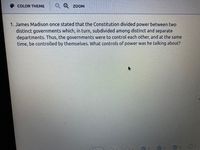Question

Transcribed Image Text:**Understanding the Division of Power in the U.S. Constitution:**
1. **Quote by James Madison**: James Madison once stated that the Constitution divided power between two distinct governments which, in turn, subdivided among distinct and separate departments. Thus, the governments were to control each other, and at the same time, be controlled by themselves. What controls of power was he talking about?
**Explanation**:
Madison refers to the architectural foundation of the United States government as outlined in the Constitution. This structure is characterized by a system of checks and balances within a federal system. The two distinct governments mentioned are the federal government and the state governments. Each government is further divided into three branches:
1. **Legislative**: Makes laws (e.g., Congress at the federal level, state legislatures at the state level).
2. **Executive**: Enforces laws (e.g., the President at the federal level, Governors at the state level).
3. **Judicial**: Interprets laws (e.g., the Supreme Court at the federal level, state courts at the state level).
Madison's observations emphasized that these branches are designed to control one another (checks and balances) while being controlled internally by their own set division of power. This design prevents any single branch or level of government from becoming too powerful, ensuring a balanced distribution of power.
Expert Solution
This question has been solved!
Explore an expertly crafted, step-by-step solution for a thorough understanding of key concepts.
This is a popular solution
Trending nowThis is a popular solution!
Step by stepSolved in 2 steps
